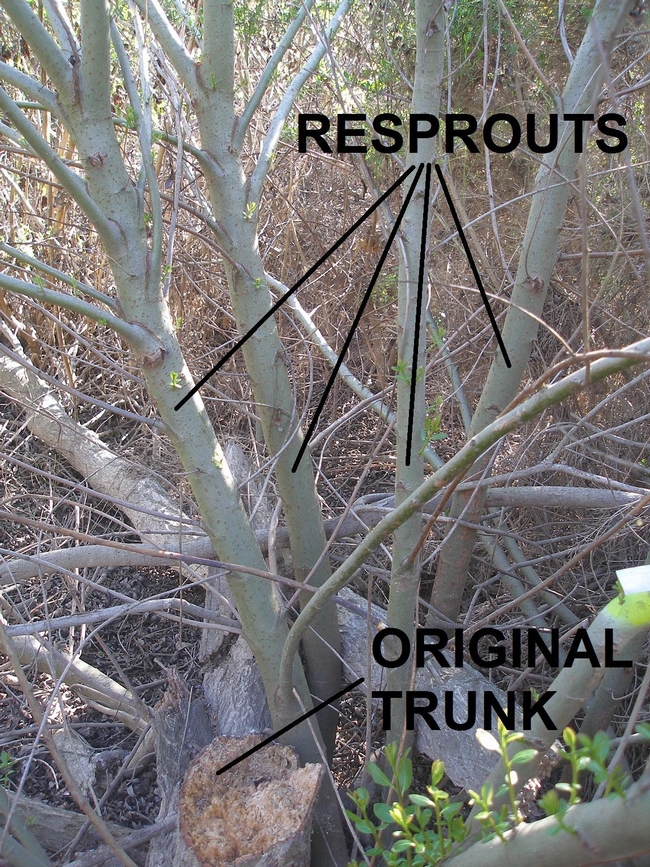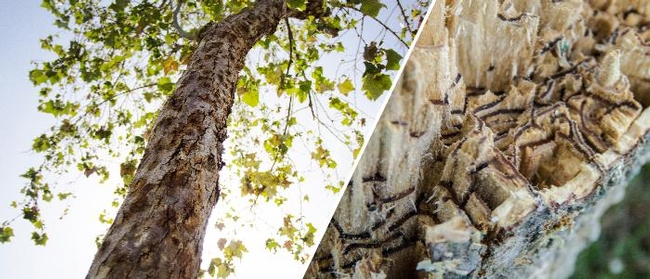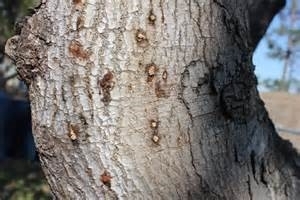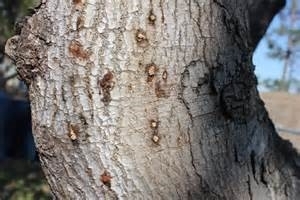
Posts Tagged: Kuroshio Shot Hole Borer
Invasive Shot Hole Borer Gone Global
Natural Resources Advisor, UC Cooperatiove Extension
With a finding in the KwaZulu National Botanical Gardens reported in November 2017, the invasive shot hole borer (ISHB) (polyphagous and Kuroshio borers)/ fusarium dieback pest disease complex is now known to be found on three continents. Native to parts of Asia – polyphagous SHB comes from Vietnam, while Kuroshio SHB is native to Taiwan – the problems has spread to Israel, the US, Mexico, and now South Africa. Since first being discovered, PSHB has been identified in urban areas in parts of the country that are several hundred miles apart – from Durban on the east coast to the large metropolitan area of Johannesburg further north, with the Botanical Garden in-between. Samples from the city of George, in a region on the southern coast known as the Garden Route, are currently being analyzed. South Africans are very concerned about the potential to damage their extensive urban forests and are developing a national surveillance and management plan. KwaZulu National Botanical Garden is part of the International Plant Sentinel Network, where exotic species are grown to provide an early warning system for emerging pests. The US counterpart if the Sentinel Plant Network run by the American Public Gardens Association and the National Plant Diagnostic Network. Finding this pest serves as a case in point on the value of these kinds of international networks in the battle against invasive pests.
Closer to home, there is actually, potentially, maybe some good news from the Tijuana River Valley. This is the valley that has been the hardest hit by the KSHB. In 2015 the natural willow forests were tall and lush and then just a few months later they were devastated - the before-and-after photos of this event have become iconic. John Boland, a researcher working in the Tijuana River Valley reports that in areas that were severely damaged by the pest, the willows are now vigorously recovering. They are growing back from their stumps via long re-sprouts, and this new growth is not showing signs of attack. Surveys in 2017/18 found a 6% median infestation rate, down from a 97% infestation rate observed in 2015/16. The initially observed high infestation rates in the wet forest areas may have been influenced by extremely high sewage pollution into the Tijuana River, and these high infestation rates are unlikely to occur elsewhere. Boland's “soft tree hypothesis” states that willows growing in nutrient enriched waters grow quickly, laying down wood with low density and high water content, i.e., they have ‘soft' wood. This kind of growth promotes beetle infestation, as it's easy to create tunnels, and favorable for the fungal symbiont. Willows growing elsewhere would have ‘hard' wood and suffer fewer beetle attacks. His initial data analysis supports this hypothesis. If true, this would mean that riparian areas with higher quality water could see much less severe infestation. It will be interesting to observe variations in infestation ecology around the region. Damage to avocado groves in California appears to be less severe than initially anticipated – I hope the same is true for natural areas.
Boland, J.M. 2018. The Kuroshio Shot Hole Borer in the Tijuana River Valleyin 2017-18 (Year Three):
Infestation Rates, Forest Recovery, and a New Model. Final Report for US Navy, US Fish and Wildlife Service and Southwest Wetlands Interpretive Association. 74 pages.
Photo: A typical resprouting arroyo willow. The original trunk is large, broken and riddled with KSHB holes. At the time of the photo, the four vertical resprouts were growing strongly and had no KSHB holes. (John Boland)

Boland willow
PSHB Found in South Africa
The following is the abstract of a recent article highlighting the occurrence of the invasive shot hole borer that is found in California and described in our blog site:
Invasive species are a problem world-wide and this is an example of how invasives can arrive in multiple countries at the same time and/or how possibly they might move from somewhere like California to another far away country like South Africa. People are the usual agents for carrying these pests around the world.
The polyphagous shot hole borer (PSHB) and its fungal symbiontFusarium euwallaceae: a new invasion in South Africa
The polyphagous shot hole borer (PSHB), an ambrosia beetle (Coleoptera: Curculeonidae: Scolytinae) native to Asia, together with its fungal symbiont Fusarium euwallaceae, has emerged as an important invasive pest killing avocado and other trees in Israel and the United States. The PSHB is one of three cryptic species in the Euwallacea fornicatusspecies complex, the taxonomy of which remains to be resolved. The surge in the global spread of invasive forest pests such as the PSHB has led to the development of programs utilizing sentinel tree plantings to record new host-pest interactions. During routine surveys of tree health in botanical gardens of South Africa undertaken as part of a sentinel project, an ambrosia beetle/fungal associate was detected damaging Platanus x acerifolia(London Plane) in the KwaZulu-Natal National Botanical Gardens, Pietermaritzburg.
Identification of the beetle by sequencing part of the mitochondrial cytochrome oxidase c subunit 1 (COI) gene confirmed its identity as PSHB, and specifically one of the invasive haplotypes of the beetle. The associated fungus F. euwallaceaewas identified based on phylogenetic analysis of elongation factor (EF 1-α) sequences. Koch's postulates have confirmed the pathogenicity of fungal isolates toP. x acerifolia. This is the first report of PSHB and its fungal symbiont causing Fusarium dieback in South Africa. This report also represents the first verified case of a damaging invasive forest pest detected in a sentinel planting project, highlighting the importance of such studies. Given the potential impact these species present to urban trees, native biodiversity and agriculture, both the PSHB and its fungal symbiont should be included in invasive species regulations in South Africa.
The full paper is at:
https://doi.org/10.1007/s13313-018-0545-0
Photo: Infected sycamore which is related to London plane tree.

PSHB sycamore
Mulch Can be Dangerous
I used to think that you could not add enough mulch into an orchard and cause any harm. Well, I've been proved wrong a number of times. Some people have gone overboard and put on three to five feet for some reason and it causes all manner of problems, the least of which is usually just getting around in the orchard. But organic matter is the energy source that drives a lot of positive good in an orchard. It provides nutrients for the plants, as well as the microbes that protect plant health, keeps weeds down and maintains an even soil moisture content.
In agriculture, mulch has been viewed as an important input to maintain good tree health, especially in avocado orchards. That has been true up until the introduction of Asian Citrus Psyllid (ACP) and Polyphagous Shot Hole Borer (PSHB, and a close relative Kuroshio Shot Hole Borer ((KSHB))) into California. These are insects that carry disease that are lethal to trees. The ACP can carry a bacteria that causes the death of citrus trees. It has been a major cause of tree death in Florida, as well as other parts of the world. It is severely threatening the industry in that State as it does in California. It also threatens all backyard citrus wherever they are found. PSHB, on the other hand, is another insect that carries a fungal disease that threatens not just one species of tree, such as avocado, but many native trees, such as coast live oak, sycamore, willow and many other native tree species.
Initially these pests were pretty much confined to the Los Angeles Basin and south, but ACP has moved into the Central Valley, and through Ventura up the coast. Its progress has been monitored by traps. PSHB has been found in parts of Ventura County, but it is not widespread, as far as we know at this point. Both insects can be easily moved by contaminated plant material. ACP can be found in infested leaves and on fruit. Moving that material increases the likelihood of spread. PSHB can be moved in wood where it makes its galleries. Moving wood and chips, can spread this pest/disease complex.
The way to help control the spread of these two pest and their disease causing organisms is to stop the spread of materials. This means don't move material from known infested areas, such as the LA Basin into Ventura. It means know where your mulch is sourced. Ideally, if you mulch, it should be with material found onsite. Chip the trees on your property and use it there. This is a threat not only to you, but your neighbors, as well. Be a good neighbor.
For more on ACP and PSHB/KSHB see:
http://eskalenlab.ucr.edu/avocado.html
http://eskalenlab.ucr.edu/distribution.html
http://eskalenlab.ucr.edu/handouts.html
http://ucanr.edu/sites/KACCitrusEntomology/Training_Materials/Educational_Materials/
Photos: ACP and PSHB

ACP adult and nymph

pshb insect
The New Borers and the Lack of Public Interest?
Without a doubt the borers, PSHB and KSHB are going to hurt avocado production, but there are some California native and landscape trees that are also going to get hammered, like unto death. Much has been written about the borers in the press, from ag journals to environmental newsletters to newspapers, such as the New York Times, Los Angeles Times and more local papers like the Ventura Star and Riverside Press-Enterprise. Recent trap findings of PSHB in Ventura county brought a local gathering of community groups to discuss the situation and the need to get more information out to local residents of the major environmental disaster at our doorstep, It seems most homeowners are not aware of the problem or if so marginally so. Is it because it's viewed as just an avocado growers' problem? The CA Avocado Commission has lead in research and spending on this problem that will affect all citizens, not just growers and consumers of the fruit. Are we all just overwhelmed by the disasters that are occurring around us here and world-wide?
I'm not sure why the lack of general interest in this issue, but the only way to get control of these pests is to stop their movement, which is largely through humans moving contaminated wood. Slowing the spread will give time to develop control methods and measures that will allow our native woodlands to cope with this infestation. There are currently people looking for pathogens and parasites in the native range of these pests, in order to determine if those native control measure would fit into a California system. But this is going to take time and in the meantime the spread needs to be slowed. Talk to your neighbors, co-workers and friends. And have them talk to their neighbors, co-workers and friends. Get the word out about what we can all do to slow the spread.
Listed below are some of the common plants in which the borer can reproduce and spread its fungi that kill the tree. Many more trees have been identified to which the borer goes, but as yet it's not known whether the fungi spread in those trees.
Known Suitable Reproductive Host Trees of PSHB:
2. Big leaf maple (Acer macrophyllum)*
3. Evergreen Maple (Acer paxii)
4. Trident maple (Acer buergerianum)
5.Japanese maple (Acer palmatum)
6. Castor bean (Ricinus communis)
7. California Sycamore (Platanus racemosa)*
8. Mexican sycamore (Platanus mexicana)
9. Red Willow (Salix laevigata)*
10. Avocado (Persea americana)
11. Mimosa (Albizia julibrissin)
12. English Oak (Quercus robur)
13. Coast live oak (Quercus agrifolia)*
14. London plane (Platanus x acerifolia)
15.Cottonwood (Populus fremontii)*
16. Black cottonwood (Populus trichocarpa)*
17. White Alder (Alnus rhambifolia)*
18.Titoki (Alectryon excelsus)
19. Engelmann Oak (Quercus engelmannii)*
20. Cork Oak (Quercus suber)
21. Valley oak (Quercus lobata)*
22. Coral tree (Erythrina corallodendon)
23. Blue palo verde (Cercidium floridum)*
24. Palo verde (Parkinsonia aculeata)
25. Moreton Bay Chestnut (Castanospermum australe)
26. Brea (Cercidium sonorae)
27. Mesquite (Prosopis articulata)*
28. Weeping willow (Salix babylonica)
29. Chinese holly (Ilex cornuta)
30. Camelia (Camellia semiserrata)
31. Acacia (Acacia spp.)
32. Liquidambar (Liquidambar styraciflua)
33. Red Flowering Gum (Eucalyptus ficifolia)
34. Japanese wisteria (Wisteria floribunda)
35. Goodding's black willow (Salix gooddingii)*
36. Tree of heaven (Alianthus altissima)
37. Kurrajong (Brachychiton populneus)
38. Black mission fig (Ficus carica)
Known Suitable Reproductive Host Trees of KSHB
1. Avocado (Persea americana)
2. California Sycamore (Platanus racemosa)*
3. Coast live oak (Quercus agrifolia)*
4. Cork oak (Quercus suber)
5. Draft coral tree (Erythrina humeana)
- Black Polar (Populus nigra)
7. Black locust (Robinia pseudoacacia)
8. Red Willow (Salix laevigata)*
- Arroyo willow (Salix lasolepis)*
- Cottonwood (Populus fremontii)*
11. Mimosa (Albizia julibrizin)
12. Castor bean (Ricinus communis)
13. Black Willow (Salix nigra)*
14. Strawberry Snowball Tree (Dombeye cacuminum)
*Native species to California
For other information sources of what these new borers can do to our wildscapes check out:
http://ucanr.edu/sites/socaloakpests/

PSHB damage
Shot Hole Borer on the Move
A note from UC Riverside Plant Pathologist, Akif Eskalen
Hello,
We just confirmed that the riparian forest in the Tijuana river valley in San Diego is infested with Kuroshio Shot Hole Borer. Rod Dossey and his team from WRA, Environmental Consultants first noticed the sign and symptoms of the beetle on Sept 25th, and contacted us for the confirmation. I have visited the site last week and mortality is already occurring on many trees including Arroyo Willow, Black Willow and Castor Bean. Please let me know if you have any questions.
PSHB/KSHB distribution map
http://ucanr.maps.arcgis.com/apps/Viewer/index.html?appid=3446e311c5bd434eabae98937f085c80
Regards
Akif

PSHB damage
